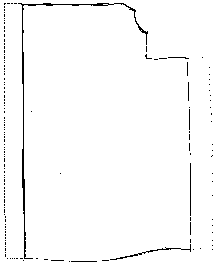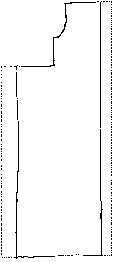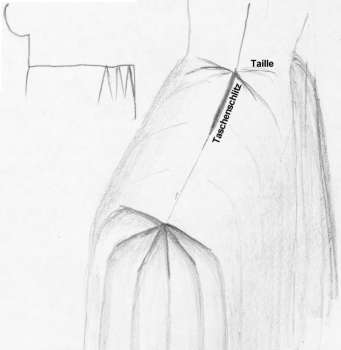| INDEX | 1300-1599 | 1600s | 1700s | 1800s | 1900s | CROSS-ERA | ETHNO | |
| MISCELLANY | CONTACT | SEARCH | |
|
|
Part 8: Variations
The pattern we have used until now is, as I have said before, only suitable
for about 1750, plus/minus five years. It is the easiest one to explain to beginners
and to fit. Once you have a well-fitted lining and understood the underlying
principle of construction, an experienced seamstress can develop any variation
from there.
From around 1755, the front was divided into a bodice and skirt part with a waist seam in between, and the bodice side seam moved towards the back to achieve a closer fit. The front skirt was cut slightly slanted so that the pattern ran parallel to the front edge, which was meant to gap in the shape of an inverted V. Actually the skirt had been meant to gap like that all along, but the cut didn't reflect that until about 1755.
When to use sleeve flounces vs. cuffs has already been discussed. The one-piece cut of the front goes well with both cuffs and flounces, while the waist seam demands flounces. It's a matter of synchronicity.
Two variations are very easy to make with the pattern we've used so far, simply by widening the skirt parts of the front and back and/or all of the back and front.


1. Early styles (c. 1720-40)
Very early robes (1720-30) were not fitted to the waist. In the very beginning, the side seam even appears not to have been attached to the lining so that the robe widens right from the armpit (see Ghersaint's shopsign). Later (around 1730) is is attached to the lining but the back still flaps loose. The front edges aren't pinned to the stays but hang loosely, are tied with bows all the way from breast to hem, or sewn closed from the waist down and only hang loose at the top. Until the early 30s, the sleeve pleats run down all the length of the sleeve, i.e. the sleeve must be wider overall, especially at the bottom. Next to the robing (front) pleat and half under it, there often is a second pleat.
To accomplish that, we need to add some width to the front: To the top for the second pleat and to the skirt to close the gap in front. Simply add some to the front edge and the skirt edge. Tucking another pleat under the robings so that it sticks out a bit from under them shouldn't be difficult. The sleeves also need about 15-20 cm additional width which will be pleated until the sleeve once again matches the pattern. If the robe is worn closed (either with a seam or with bows) from the waist down, you can dispense with the jupe.
2. Wide paniers
In the 1740s the paniers are often very wide, but flat in front and back. Same goes for later, ceremonial styles. The skirt - both robe skirt and jupe - must be accordingly wider, possibly widening even more towards the hem, while the top of the robe sticks with whatever was in fashion at the time. In this case, we simply widen the skirt parts, both in front and back, to accomodate the wider panier. The top of the skirt, measured from bodice side to skirt side seam, must correspond to the width of the panier between those points, and some. This "some" is pleated into a fan shape at the point where the panier angles down, instead of the pleats we have, until now, pleated into the side seam. See sketches below for narrow (left) and wide (right) paniers.


The width of the pleated back can also be varied. This is of special interest to those who find themselves with not enough fabric for the back pleats. Up until now we have assumed that the pleats go from armhole to armhole. However, from about 1750 on, the pleated part became narrower. So if making shallower pleats isn't enogh to make up for your lack of fabric, go for a later style. Start by making the outermost pleat lie 2-3 shy of the armhole. Remember that such a late (c. 1760-70) style also requires trimmings, so the overall fabric consumption is almost the same - just distributed differently.
If you still haven't got enough back width, you must go for an even later style: The Robe à la piemontaise, c. 1780, which is made with a fitted back and has the back pleats attached extra.
Back to the main contouche page
Content, layout and images of this page
and any sub-page of the domains marquise.de, contouche.de, lumieres.de, manteau.de and costumebase.org are copyright (c) 1997-2022 by Alexa Bender. All rights reserved. See Copyright Page. GDPO
This work is licensed under a Creative Commons License.